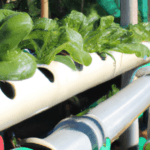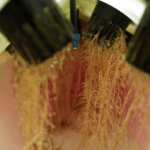12 SURPRISING BENEFITS OF INDOOR FARMING
In recent years, indoor farming, or vertical farmingA method of growing plants in vertically stacked layers or t... More or indoor gardening, has emerged as an innovative and sustainable solution to modern agricultural challenges. By cultivating crops in controlled indoor environments using advanced technologies, indoor farming offers many benefits beyond traditional farming methods. In this comprehensive blog post, we will explore the ten surprising benefits of indoor farming and how it shapes the future of agriculture.
Table of Contents
1. Increased Crop Yield
One of the standout advantages of indoor farming is the significant increase in crop yields compared to traditional farming methods. Through advanced techniques such as hydroponics A soilless cultivation method where plants are grown in nutr... More and aeroponics
A soilless cultivation method where plants are grown in nutr... More and aeroponics A hydroponic system where plant roots are suspended in... More, indoor farmers can precisely control nutrient delivery, resulting in healthier and more productive plants and increased crop yields compared to traditional farming methods.
A hydroponic system where plant roots are suspended in... More, indoor farmers can precisely control nutrient delivery, resulting in healthier and more productive plants and increased crop yields compared to traditional farming methods.
2. Year-round Crop Production
Indoor farming allows for year-round crop production unaffected by external weather conditions. Farmers can provide optimal growing conditions by creating controlled environments, resulting in consistent and continuous crop production.
By creating controlled environments with optimal lighting, temperature, and humidity, indoor farmers can cultivate crops continuously, ensuring a steady and reliable fresh produce supply.
3. Water Conservation
Water scarcity is a growing concern in agriculture, but indoor farming addresses this issue with water-efficient practices. Using recirculating systems and precision irrigation, indoor farms can reduce water consumption by up to 90% compared to conventional farming.
4. Reduced Dependency on Pesticides
By creating a controlled and sterile environment, indoor farming minimizes the risk of pests and diseases. This reduction in external threats reduces reliance on harmful pesticides, making indoor agriculture more sustainable and eco-friendly.
5. Improved Food Safety
With no need for chemical pesticides, herbicides, or fungicides used in traditional agriculture, indoor farming produces food free from harmful residues, promoting improved food safetyPractices and measures employed to ensure the safety and qua... More and quality. This aspect particularly appeals to health-conscious consumers seeking safer, more nutritious food free from toxic residues.
6. Minimal Space Requirement
Indoor farming utilizes vertical space efficiently, allowing for high-density crop production in a relatively small area. Using vertical spaces more efficiently makes indoor farming suitable for urban areas with limited land availability.
Vertical space and multi-tier systems allow indoor farmers to grow substantial food in relatively small areas, making it ideal for urban agriculture.
7. Enhanced Nutritional Value
With precise control over growing conditions, indoor farming can optimize nutrient delivery, resulting in crops with enhanced nutritional value. This provides consumers with healthier and more nutritious food options.
8. Climate Change Resilience
Indoor farming is less vulnerable to the effects of climate change. Creating controlled environments mitigates the impact of extreme weather events, ensuring a stable and reliable food production system.
9. Urban Agriculture
Indoor farming can transform urban spaces into productive agricultural areas. By converting abandoned buildings or utilizing rooftop spaces, cities can become more self-sufficient in food production, reducing the carbon footprintThe total amount of greenhouse gas emissions, primarily carb... More associated with transportation.
10. Economic Viability
While the initial setup costs of indoor farming may be higher, the long-term benefits make it economically viable. Higher crop yields, reduced water usage, and minimized pesticide dependence contribute to cost savings and increased profitability.
11. Energy Efficiency
While indoor farming requires energy to power artificial lightingThe use of artificial light sources, such as LED or fluoresc... More and climate control systems, advancements in energy-efficient technologies make it more sustainable. The incorporation of renewable energy sources further enhances its environmental benefits.
12. Sustainable Urban Development
Indoor farming contributes to sustainable urban development by repurposing abandoned buildings, warehouses, and rooftops for agriculture. This localized approach reduces the carbon footprintThe total amount of greenhouse gas emissions, primarily carb... More of transporting food long distances, promoting a greener urban environment.
Indoor farming provides numerous surprising benefits that revolutionize the future of agriculture. By increasing crop yields, enabling year-round crop production, conserving water, reducing dependency on pesticides, and improving food safetyPractices and measures employed to ensure the safety and qua... More, indoor farming offers a sustainable solution to the challenges faced by traditional agriculture.
In addition, indoor farming’s minimal space requirement, enhanced nutritional value, climate change resilience, and urban agriculture potential make it a viable option for addressing land scarcity, promoting healthier food choices, adapting to changing climatic conditions, and integrating agriculture into urban environments.
With its many benefits, indoor farming represents a significant advancement in the agricultural industry. As the world faces increasing demands for food production, indoor farming offers a sustainable and efficient way to meet these challenges while ensuring the availability of safe, nutritious, and high-quality produce.
FAQs
Is indoor farming only suitable for leafy greens and herbs?
No, indoor farming can be used to cultivate a wide variety of crops, including fruits, vegetables, and even certain types of grains. The controlled environment allows for precise control over growing conditions, making it adaptable to different plant species.
How does indoor farming reduce water consumption?
Indoor farming utilizes hydroponics A soilless cultivation method where plants are grown in nutr... More or aeroponics
A soilless cultivation method where plants are grown in nutr... More or aeroponics A hydroponic system where plant roots are suspended in... More systems, where plants are grown without soil. This eliminates the need for excessive watering and allows for efficient recycling and reuse of water within closed-loop systems.
A hydroponic system where plant roots are suspended in... More systems, where plants are grown without soil. This eliminates the need for excessive watering and allows for efficient recycling and reuse of water within closed-loop systems.
Can indoor farming replace traditional agriculture completely?
Indoor farming offers numerous advantages and has the potential to supplement traditional agriculture, especially in urban areas or regions with limited arable land. However, it is unlikely to completely replace traditional agriculture, as certain crops and farming practices are better suited for outdoor cultivation.
What are the energy requirements for indoor farming?
Indoor farming relies on artificial lightingThe use of artificial light sources, such as LED or fluoresc... More systems, which can consume a significant amount of energy. However, advancements in LED technology have made indoor farming more energy-efficient compared to traditional lighting sources. Additionally, integrating renewable energy sources such as solar panels can help further reduce the environmental impact of indoor farming operations.
Is indoor farming pesticide-free?
Indoor farming methods like hydroponics A soilless cultivation method where plants are grown in nutr... More and aeroponics
A soilless cultivation method where plants are grown in nutr... More and aeroponics A hydroponic system where plant roots are suspended in... More reduce the need for pesticides as compared to traditional agriculture. The controlled environment and close monitoring allow for early detection and prevention of pests and diseases. Integrated pest managementStrategies and techniques employed to prevent and control pe... More techniques, such as introducing beneficial insectsInsects that are intentionally introduced into an indoor far... More or using organic pest controlThe use of natural methods, such as beneficial insects, bota... More methods, can further minimize the use of pesticides in indoor farming.
A hydroponic system where plant roots are suspended in... More reduce the need for pesticides as compared to traditional agriculture. The controlled environment and close monitoring allow for early detection and prevention of pests and diseases. Integrated pest managementStrategies and techniques employed to prevent and control pe... More techniques, such as introducing beneficial insectsInsects that are intentionally introduced into an indoor far... More or using organic pest controlThe use of natural methods, such as beneficial insects, bota... More methods, can further minimize the use of pesticides in indoor farming.
Pingback: Mastering Climate Control in Indoor Farming - indoorfarminghub.com
Pingback: Illuminating Indoor Farming with Lighting Systems - indoorfarminghub.com